Sales teams create value when they do what they do best. Their core strength is delivering products and services with the best customer experience (CX).
However, considerable time can be spent managing data and processes on the backend of those relationships. This is where customer relationship management (CRM) comes in.
CRM systems underpin the entire sales lifecycle. They help sales representatives streamline key processes and workflows, allowing them to focus on what they do best: delivering exceptional CX.
Low user adoption of CRM tools can end even the most ambitious sales or product campaign. And this happens more than you may think. Finance Online figures show that 22% of sales professionals are still unsure about CRM.
To help firms avoid this, we’ll share ten methods for boosting CRM adoption, exploring its importance, benefits, and challenges. We’ll also explore why driving CRM adoption is important and some common reasons for CRM adoption failure.
What is CRM adoption?
CRM adoption describes the efficient integration of CRM software solutions. It’s when a company leverages the software’s full potential, allowing end-users to realize its benefits.
Modern CRMs extend beyond basic contact management. Modern solutions offer features that facilitate smoother sales processes, enhance workflow productivity, and empower representatives to move customers along the pipeline faster.
Research from Statista shows that worldwide revenue from the CRM market amounted to $69 billion U.S. dollars, up from $14 billion U.S. dollars in 2010. This equals a $55 billion difference, or a staggering 393% increase.

10 Methods for increasing CRM user adoption

Implementing these ten strategies focused on user adoption will transform your CRM from a complex tool into a valued team asset.
1. In-app guidance for instant support
Imagine having a personal guide within your CRM, ready to answer your questions and show you exactly what to do at every step.
That’s the power of digital adoption platforms (DAPs). Unlike traditional training methods, DAPs provide instant, contextual help within the CRM interface.
No more switching between screens or forgetting crucial steps. Sales representatives can access bite-sized walkthroughs and tutorials when they need them. This minimizes frustration and maximizes efficiency.
In-app guidance empowers teams to master new features quickly. This often leads to smoother workflows, increased confidence, and higher CRM adoption rates.
It’s an easy decision. DAPs are a game-changer, transforming your CRM from a complex tool into a valuable asset that drives sales success.
2. Make employees part of the process
The best way to ensure the success of your CRM is to make your employees feel that they have a stake in it.
Instead of just handing them a new tool, involve them in decision-making. Ask for their input during the selection phase – what do they wish their current system did better? What are their daily problems when managing customer data?
This participation should not stop after the CRM is launched. Continue gathering feedback and adjusting the system based on their real-world experiences.
This ongoing dialogue shows that their voices matter and that the CRM supports their work, not dictates it. By turning employees into partners, you foster a sense of ownership. They’ll be more willing to learn the ins and outs of the platform, explore its benefits, and champion its success within the team.
3. Tailor dashboards for user needs
Imagine your CRM dashboard as the mission control center for your sales or customer-facing team.
A one-size-fits-all dashboard creates unnecessary friction, leading to frustration and wasted time. Tailoring dashboards eliminates this obstacle and puts the power in the hands of individual users.
This focus on the user experience significantly affects adoption. Resistance decreases when the CRM’s intuitive, relevant, helpful, and engagement skyrockets. Tailoring shows an understanding of diverse roles and workflows. It promotes empowerment by removing unnecessary steps and making the CRM an extension of the user’s daily routine.
Think of your CRM dashboard as the control panel for your sales team’s success. A cluttered, generic dashboard creates confusion and slows users down. Tailored dashboards eliminate this friction.
You streamline their workflow by allowing users to prioritize the data and tools they use most. They do not have to hunt for information or navigate through irrelevant sections.
4. AI-powered data cleanup for trust
Bad data is a silent killer for sales teams. Outdated contact information, incorrect lead statuses, and duplicate entries create roadblocks in the sales process.
Sales representatives waste time chasing phantom leads and struggle to personalize their outreach. This damages customer relationships with outdated information.
AI-powered data cleanup tools offer a lifeline. They automate error identification, merge duplicates, and enrich records with up-to-date insights.
This relentless focus on data integrity has a profound impact. Sales representatives gain confidence in their CRM, allowing them to focus on building relationships and closing deals.
A clean CRM transforms from a source of frustration into a powerful tool that increases adoption and improves sales outcomes.
5. Build a team of CRM champions
CRM adoption thrives when users feel supported and inspired.
A team of CRM champions acts as an internal network of experts and enthusiasts. These early adopters are passionate about the platform and eager to share their knowledge. They provide on-the-ground support, answering questions and troubleshooting issues for their colleagues.
Champions also lead by example. They show how the CRM streamlines workflows and improves results. This peer-to-peer influence is incredibly powerful in motivating others.
A CRM champion network builds a culture of excitement and collaboration around the system. This fosters a community and makes CRM adoption feel like a team effort.
6. Targeted training when it matters
Long, generic training sessions often fail to stick. Targeted training delivers the right information at the right time.
Instead of overwhelming users, focus on bite-sized lessons covering specific features or tasks. Offer microlearning and interactive eLearning when users are most likely to need them. Examples include during onboarding, a feature rollout, or when they are trying to complete a workflow.
This “in the moment” training reduces frustration and immediately reinforces new skills. Users do not have to search for answers or recall information from outdated sessions.
Relevant, timely training makes the CRM feel intuitive and translates to higher user confidence and long-term adoption.
7. Instant help within your CRM
A lack of immediate support can create major roadblocks for CRM users.
Instant help embedded within the CRM eliminates this obstacle. On-demand resources, such as walkthroughs, knowledge bases, or chat support, offer solutions at the precise moment of need. This seamless access to help empowers users to resolve challenges independently.
Self-sufficiency builds confidence and reduces frustration. Time is not wasted searching for answers or waiting for external support. Users see the CRM as a problem-solving tool rather than a source of delays.
This positive experience translates into higher adoption rates. Individuals feel comfortable exploring the platform and using its full potential.
8. Practice makes perfect with VR
Traditional training methods often cannot prepare users for the dynamic and sometimes complex world of a CRM.
VR simulations offer a game-changing solution. Immersing users in realistic virtual environments enables them to practice interface navigation. They can also manage customer interactions and handle data without fearing real-world consequences.
This hands-on experience builds muscle memory and allows users to learn from mistakes.
When transitioning to the live CRM environment, they feel more prepared and less apprehensive.
The confidence gained through VR reduces reliance on support and encourages exploration.
This low-pressure learning experience enables smoother CRM adoption, transforming the platform into a valued tool.
9. Stay updated with in-app CRM alerts
Changes to CRM processes can be disruptive if not communicated effectively. In-app alerts provide a seamless solution. They notify users directly within the platform about updates, new features, or important reminders. This proactive communication eliminates confusion and guesswork.
Sellers stay informed without having to search through emails or external documents. This keeps their focus on using the CRM, not figuring out how it works. Clarity builds confidence, reduces frustration, and promotes a sense of control.
When users feel supported and in the loop, they are more likely to embrace the system and adapt to changes quickly, accelerating CRM adoption.
10. Rewards drive early engagement
The initial stages of CRM adoption are crucial. Rewards programs create a sense of excitement and encourage users to actively engage with the platform.
Offer incentives for completing training modules, updating records, or achieving specific CRM-related goals.
Experimental learning makes learning fun and creates a sense of accomplishment. Rewards provide tangible recognition for users who embrace the CRM early on.
This positive reinforcement motivates exploration and helps establish the CRM as critical to workflow. Creating a sense of ownership and rewarding progress can drive higher adoption rates and set the stage for long-term success.
The cost of low CRM adoption
Businesses today face an undeniable challenge. That being said, the increasing complexity of meeting customers’ diverse wants and expectations.
Sales and marketing teams, stretched thin by growing customer bases, struggle to keep up.
Competition breeds innovation, and technology for managing customer relationships, such as CRMs, is evolving rapidly.
CRMs have become key to successful B2C practices. They improve productivity and empower teams to deliver exceptional products and services.
It’s clear that adopting CRM technology is not a choice for future-focused businesses. The cost of low CRM adoption is simply too high. Businesses risk losing customers to competitors with better data management, suffer from disjointed workflows that waste time and resources, and fail to gain the insights needed to fuel growth.
Low adoption means missing out on the very benefits a CRM is designed to deliver.
The key to successful CRM adoption lies in the ability to change. Business leaders must ensure that this change starts within the minds of their employees.


